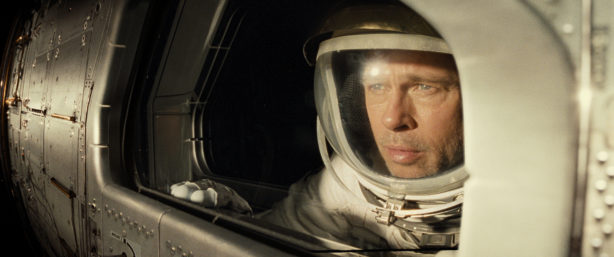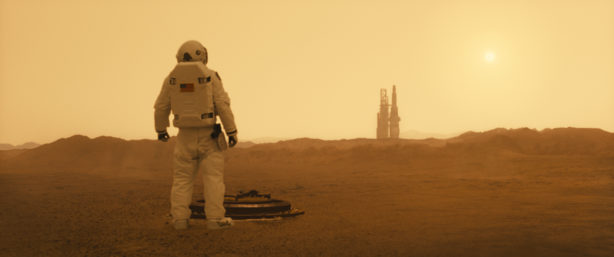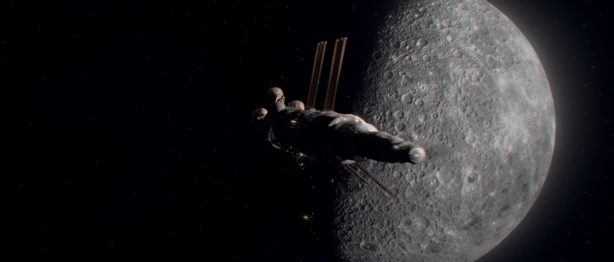Ad Astra, a paranoid thriller set in space, opens in theaters nationwide today. Directed by James Gray, from a screenplay by Gray and Ethan Gross, the latest production from 20th Century Fox follows astronaut Maj. Roy McBride (Brad Pitt) on a mission across a merciless solar system to uncover the truth about his missing father (Tommy Lee Jones) and his doomed expedition that, 30 years later, threatens both the universe’s existence and humans’ place in it.
In between projects, Gray spent over a decade developing his dream project, set in outer space, with Gross. The two continued to work on the script intermittently, with Rodrigo Teixeira’s RT Features helping them to develop it further. Pitt later agreed to star in and produce the film through his production company, Plan B. Before production began, the filmmakers decided to shoot on practical locations, rather than on soundstages, in and around the Los Angeles area.

To ground the ambitious epic in reality, the filmmakers worked closely with NASA and other space agencies. “We did a lot of research to make it as believable and scientifically accurate as possible,” Gray explains. “But we always let the story be the main impetus to drive the movie.”
When Gray was deep in the middle of pre-production on Ad Astra, which also stars Ruth Negga, Liv Tyler and Donald Sutherland, the filmmaker decided to host a special dinner for astronauts and experts from NASA, NASA Jet Propulsion Laboratory (JPL), SpaceX and other firms. “It was a spectacular exchange of ideas and insight into where they think things are going and where they have been. Sometimes you have to look backwards in order to look forward,” he reasons. “It was very instructional to me.”
Retired astronaut Garrett Reisman, who flew two Space missions to the International Space Station in 2008 and 2010, served as a resource for Gray during the screenwriting process. He was also on set during scenes that required his specific knowledge and expertise. “A lot of us now are looking at maybe making a sustainable human presence on another planet in our solar system, and specifically the red planet, and thinking about all the wonderful utopia that it might be. And I think that we have to consider: What if it turns out that it’s not a utopia? What if it’s a dystopia? And what if we can break the bonds of gravity and with our rockets and that advanced technology transport humanity to another planet, but we take our human failings along with us? What if it doesn’t turn out well?” he asks. “James explores that with this movie.”

Aerospace engineer Robert Yowell, a 30-year veteran of NASA’s Space program, also aided Gray and Gross during the production. “James wanted as much realism as possible on this film,” says Yowell. “I read the script and pointed out some suggestions. What he was looking for in terms of realism was the physics. For instance: ‘Could you fire a gun on the Moon?’ The answer is yes, a standard gun will work in space; a bullet has its own oxidizer. Another question was, ‘Can you talk to somebody on Neptune from Earth in real-time?’ Unfortunately, you can’t. As far as we know, the speed of light is the speed of light, so you’ve got a considerable delay in terms of hours. ‘What would blood look like in zero gravity? What would a dead person look like in space?’ These are things that are macabre to think about, but someday someone is going to have to deal with those eventualities. And yes, the way those things will look is physics. He also had questions about nuclear and gamma ray radiation, neutron radiation, matter and anti-matter. Our conversations were always very interesting and his questions well thought out.”
On September 12, Gray and Gross hosted two engaging conversations with leading NASA astronauts, engineers and scientists at the Blakeley Theater on the Fox lot to discuss what’s next for space exploration. The talks featured Lara Kearney, deputy program manager, Gateway Program; Nujoud Merancy, chief, Exploration Mission Planning Office; Jessica Vos, Orion Crew systems engineer; Laura Kerber, planetary scientist, JPL; Rob Manning, chief engineer, JPL; Steve Lee, Curiosity Rover deputy project manager, JPL; and astronaut Tracy Caldwell Dyson.

“There’s no picture I can take that would give you the sense that you are really above the atmosphere—that you are there,” says Dyson, who has logged more than 188 days in space, including more than 22 hours in three spacewalks. “It’s just something to behold with your own eyes. Everything from the color of the Earth and how it changes depending on the angle of the sun, to the way the sun appears as it’s going below the horizon, to the way that the space station lights up and cools down as the sun is moving, to the shapes of objects, like the moon itself—it’s ineffable. When you look out in the blackness of space, you’re looking at stars that are just solid bright objects; you’re not looking at the light blinking like you do here on Earth… If you look long enough, you can actually sense depth between the stars, whereas here, you’re looking up at an atmosphere and everything looks two-dimensional, like it’s on the same plane. It’s breathtaking and it’s emotional. The first time I saw that, it got blurry fast; I didn’t know what was happening. It turned out I was crying and I didn’t realize it! In space, tears don’t fall.”
However, they do in Ad Astra. Pitt’s character sheds a tear during a pivotal moment just before the film’s finale. After shooting the scene, the actor asked that his tear be erased in post-production, since it defies the laws of zero gravity. Citing artistic license, Gray decided to keep Pitt’s tear intact. Gray recalled telling him, “Sorry, I’m keeping it. The acting’s too good, buddy.”
Ad Astra, which won raves after it premiered at the Venice Film Festival in August, has been “certified fresh” on Rotten Tomatoes, with 81% of critics’ giving it their official seal of approval.